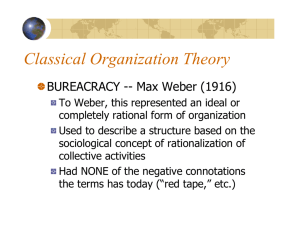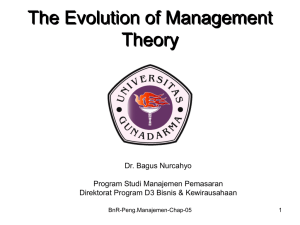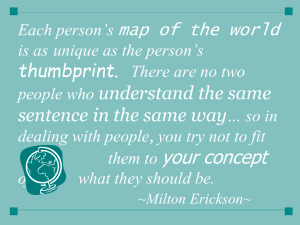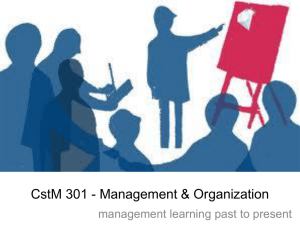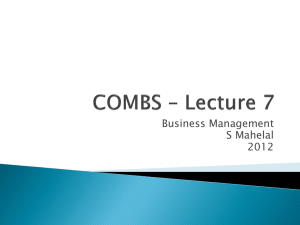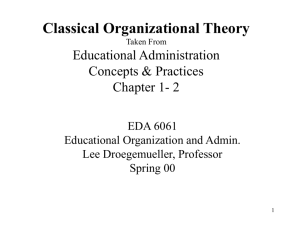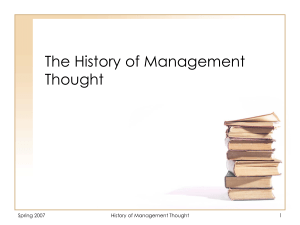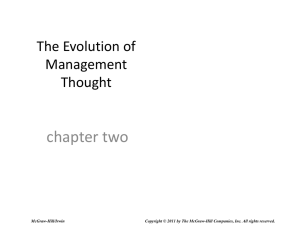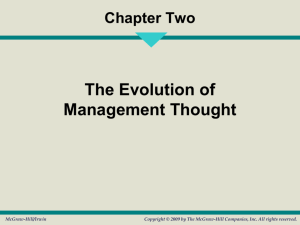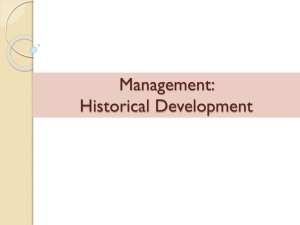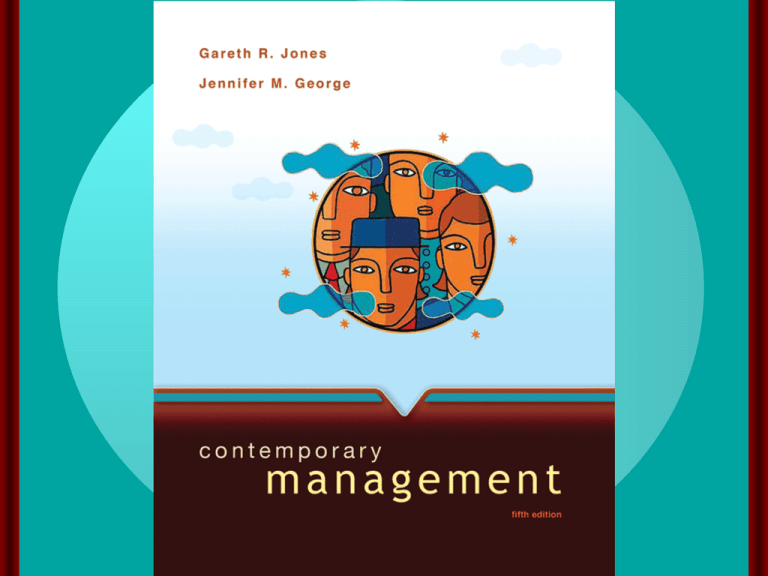
chapter two
The Evolution of Management
Thought
McGraw-Hill/Irwin
Contemporary Management, 5/e
Copyright © 2008 The McGraw-Hill Companies, Inc. All rights reserved.
Learning Objectives
•
•
•
Describe how the need to increase
organizational efficiency and effectiveness
has guided the evolution of management
theory
Explain the principle of job specialization and
division of labor, and tell why the study of
person-task relationships is central to the
pursuit of increased efficiency
Identify the principles of administration and
organization that underlie effective
organizations
2-3
Learning Objectives
Trace the change in theories about how managers
should behave to motivate and control employees
Explain the contributions of management science
to the efficient use of organizational resources
Explain why the study of the external environment
and its impact on an organization has become a
central issue in management thought
2-4
The Evolution of Management Theory
Figure 2.1
2-5
Job Specialization and
the Division of Labor
Adam Smith (18th century economist)
– Observed that firms manufactured
pins in one of two different ways:
- Craft-style—each worker did all
steps.
- Production—each worker
specialized in one step.
2-6
Job Specialization and
the Division of Labor
• Job Specialization
– process by which a division of labor occurs
as different workers specialize in specific
tasks over time
2-7
Job Specialization and
the Division of Labor
• Workers who specialized became much
more skilled at their specific tasks
• Increasing job specialization increases
efficiency and leads to higher
organizational performance
2-8
F.W. Taylor and Scientific
Management
Scientific Management
The systematic study of the
relationships between people and
tasks for the purpose of redesigning
the work process to increase
efficiency.
2-9
Four Principles of Scientific
Management
1) Study the way workers perform their tasks,
gather all the informal job knowledge that
workers possess and experiment with ways
of improving how tasks are performed
•
Time-and-motion study
2-10
Four Principles of Scientific
Management
2) Codify the new
methods of
performing tasks
into written rules
and standard
operating
procedures
2-11
Four Principles of Scientific
Management
3) Carefully select workers who possess
skills and abilities that match the
needs of the task, and train them to
perform the task according to the
established rules and procedures
2-12
Four Principles of Scientific
Management
4) Establish a fair or acceptable level of
performance for a task, and then
develop a pay system that provides a
reward for performance above the
acceptable level
2-13
Problems with Scientific Management
• Managers frequently implemented only the
increased output side of Taylor’s plan.
– Workers did not share in the increased
output.
• Specialized jobs became very boring, dull.
– Workers ended up distrusting the Scientific
Management method.
• Workers could purposely “under-perform.”
– Management responded with increased use
of machines and conveyors belts.
2-14
The Gilbreths
1. Break up and analyze every individual
action necessary to perform a particular
task into each of its component actions
2. Find better ways to perform each
component action
2-15
The Gilbreths
3. Reorganize each of the component
actions so that the action as a whole
could be performed more efficiently-at
less cost in time and effort
2-16
Administrative Management Theory
• Administrative
Management
– The study of how to
create an organizational
structure that leads to
high efficiency and
effectiveness.
2-17
Administrative Management Theory
Max Weber
–Developed the principles of bureaucracy as a
formal system of organization and
administration designed to ensure efficiency
and effectiveness.
2-18
Weber’s
Principles of
Bureaucracy
Figure 2.2
2-19
Weber’s Principles of Bureaucracy
1) A manager’s formal authority derives
from the position he holds in the
organization.
2) People should occupy positions
because of their performance, not
because of their social standing or
personal contacts.
2-20
Weber’s Principles of Bureaucracy
3) The extent of each position’s formal
authority and task responsibilities and
it’s relationship to other positions
should be clearly specified.
4) Authority can be exercised effectively
when positions are arranged
hierarchically, so employees know
whom to report to and who reports to
them.
2-21
Weber’s Principles of Bureaucracy
5) Managers must create a well-defined
system of rules, standard operating
procedures,
and norms so they
can effectively
control behavior .
2-22
Rules, SOPs and Norms
• Rules – formal written instructions that specify
actions to be taken under different circumstances
to achieve specific goals
• Standard Operating Procedures (SOPs) –
specific sets of written instructions about how to
perform a certain aspect of a task
• Norms – unwritten, informal codes of conduct that
prescribe how people should act in particular
situations
2-23
Fayol’s Principles of Management
• Division of Labor: allows for job specialization.
– jobs can have too much specialization leading to
poor quality and worker dissatisfaction.
• Authority and Responsibility
– both formal and informal authority resulting from
special expertise.
• Unity of Command
– Employees should have only one boss.
2-24
Fayol’s Principles of Management
• Line of Authority
– A clear chain of command from top to
bottom of the firm.
• Centralization
– The degree to which authority rests at the
top of the organization.
• Unity of Direction
– A single plan of action to guide the
organization.
2-25
Fayol’s Principles of Management
• Equity - The provision of justice and the fair
and impartial treatment of all employees.
• Order - The arrangement of employees where
they will be of the most value to the
organization and to provide career
opportunities.
• Initiative - The fostering of creativity and
innovation by encouraging employees to act
on their own.
2-26
Fayol’s Principles of Management
• Discipline
– Obedient, applied, respectful employees
are necessary for the organization to
function.
• Remuneration of Personnel
– An equitable uniform payment system that
motivates contributes to organizational
success.
2-27
Fayol’s Principles of Management
• Stability of Tenure of Personnel
– Long-term employment is important for the
development of skills that improve the
organization’s performance.
• Subordination of Individual Interest to the
Common Interest
– The interest of the organization takes
precedence over that of the individual
employee.
2-28
Fayol’s Principles of Management
Esprit de corps
– Comradeship, shared enthusiasm
foster devotion to the common cause
(organization).
2-29
Behavioral Management Theory
Behavioral Management
– The study of how managers should
personally behave to motivate employees
and encourage them to perform at high
levels and be committed to the achievement
of organizational goals.
2-30
Behavioral Management
Mary Parker Follett
– Concerned that Taylor ignored the
human side of the organization
• Suggested workers help in
analyzing their jobs
• If workers have relevant knowledge
of the task, then they should control
the task
2-31
The Hawthorne Studies
Studies of how characteristics of the work
setting affected worker fatigue and
performance at the Hawthorne Works of
the Western Electric Company from
1924-1932.
2-32
The Hawthorne Studies
– Worker productivity was measured at
various levels of light illumination.
– Researchers found that regardless of
whether the light levels were raised or
lowered, worker productivity
increased.
2-33
The Hawthorne Studies
Human Relations Implications
– Hawthorne effect — workers’ attitudes
toward their managers affect the level of
workers’ performance
2-34
The Hawthorne Studies
• Human relations movement – advocates
that supervisors be behaviorally trained
to manage subordinates in ways that
elicit their cooperation and increase their
productivity
2-35
The Hawthorne Studies
Implications
• Behavior of managers and workers in the
work setting is as important in explaining
the level of performance as the technical
aspects of the task
2-36
The Hawthorne Studies
• Demonstrated the importance of
understanding how the feelings,
thoughts, and behavior of work-group
members and managers affect
performance
2-37
Theory X and Theory Y
Douglas McGregor proposed the two different
sets of assumptions about workers.
– Theory X assumes the average worker is
lazy, dislikes work and will do as little as
possible.
• Workers have little ambition and wish to
avoid responsibility
• Managers must closely supervise and
control through reward and punishment.
2-38
Theory X and Theory Y
– Theory Y assumes workers are not
lazy, want to do a good job and the job
itself will determine if the worker likes
the work.
• Managers should allow workers
greater latitude, and create an
organization to stimulate the
workers.
2-39
Theory X vs. Theory Y
Figure 2.3
2-40
Management Science Theory
• Contemporary approach to management
that focuses on the use of rigorous
quantitative techniques to help
managers make maximum use of
organizational resources to produce
goods and services.
2-41
Management Science Theory
– Quantitative management — utilizes
linear and nonlinear programming,
modeling, simulation, queuing theory
and chaos theory.
– Operations management —
techniques used to analyze any aspect
of the organization’s production
system.
2-42
Management Science Theory
– Total Quality Management (TQM) —
focuses on analyzing input,
conversion, and output activities to
increase product quality.
– Management Information Systems
(MIS) — provides information vital for
effective decision making.
2-43
Organizational Environment Theory
Organizational Environment –
The set of forces and conditions that
operate beyond an organization’s
boundaries but affect a manager’s ability
to acquire and utilize resources
2-44
The Open-Systems View
Open System
– A system that takes resources for its
external environment and transforms
them into goods and services that are
then sent back to that environment
where they are bought by customers.
2-45
Figure 2.4
2-46
The Open-Systems View
– Inputs: the acquisition of external resources
to produce goods and services
– Conversion: transforms the inputs into
outputs of finished goods and services.
– Output: the release of finished goods and
services to its external environment.
2-47
Closed System
• A self-contained system that is not
affected by changes in its external
environment.
• Likely to experience entropy and lose its
ability to control itself
2-48
Systems
• Synergy – the performance gains that
result from the combined actions of
individuals and departments
– Possible only in
an organized system
2-49
Contingency Theory
• “There is no one best way to organize”
• The idea that the organizational
structures and control systems manager
choose depend on—are contingent on—
characteristics of the external
environment in which the organization
operates.
2-50
Contingency Theory
Figure 2.5
2-51
Type of Structure
Mechanistic Structure
– Authority is centralized at the top.
– Emphasis is on strict discipline and order
– Employees are closely monitored and
managed.
– Can be very efficient in a stable
environment.
2-52
Type of Structure
Organic Structure
– Authority is decentralized throughout
the organization.
– Departments are encouraged to take a
cross-departmental or functional
perspective
– Works best when environment is
unstable and rapidly changing
2-53


